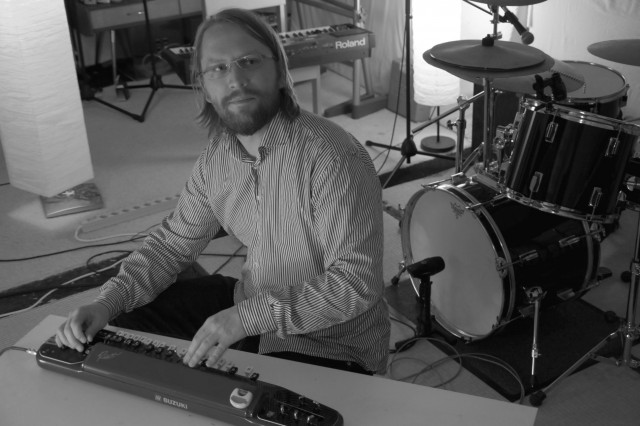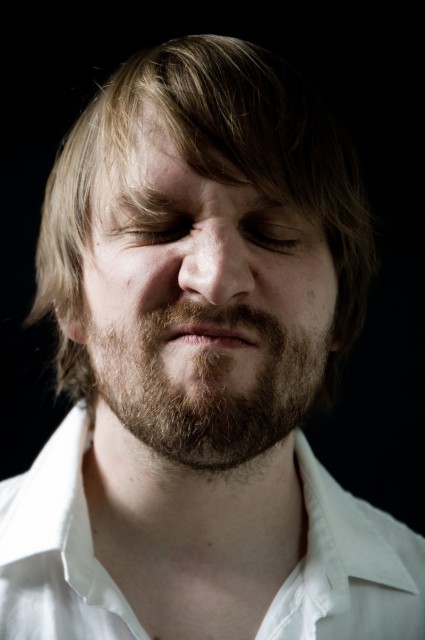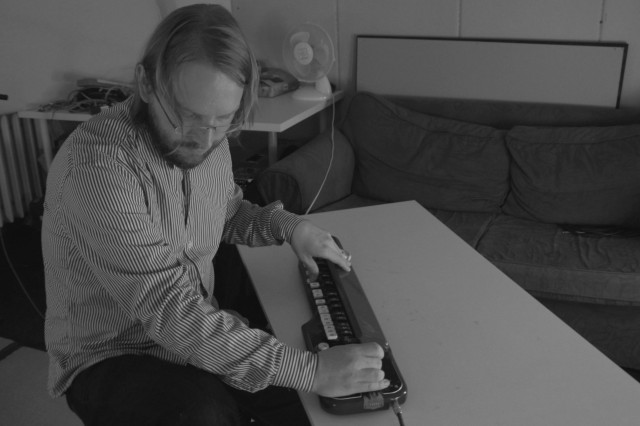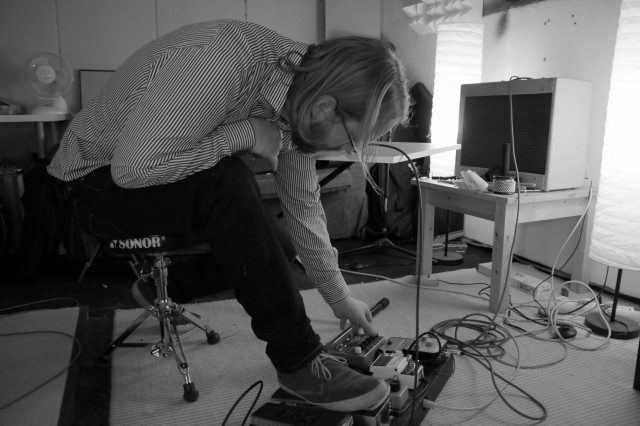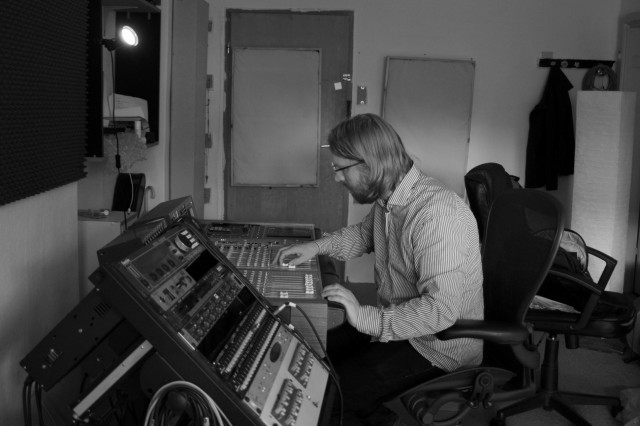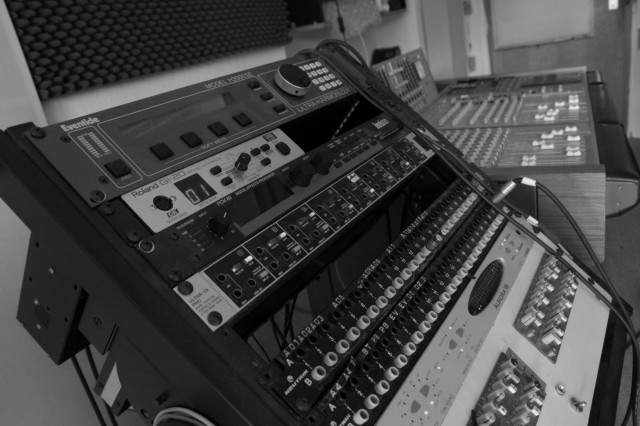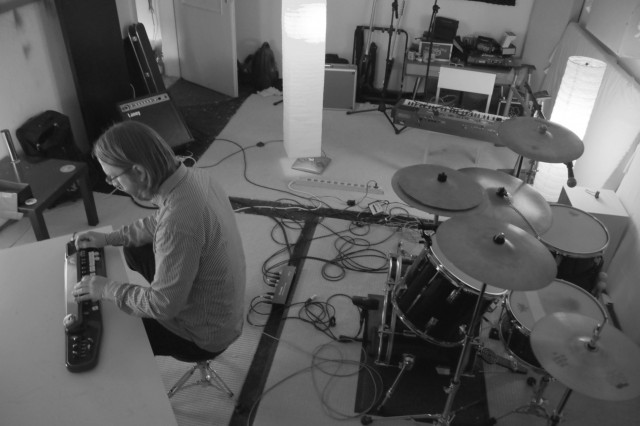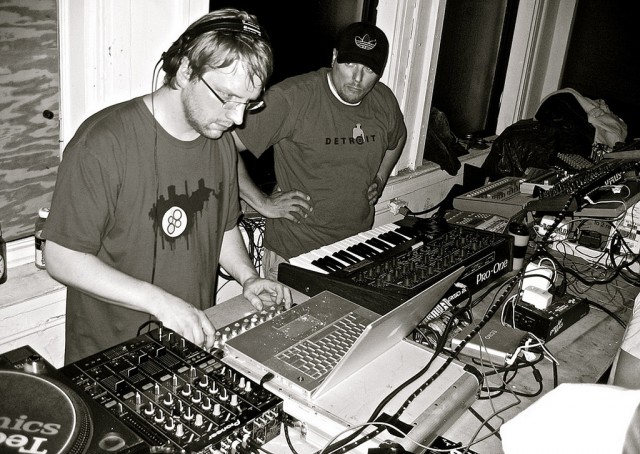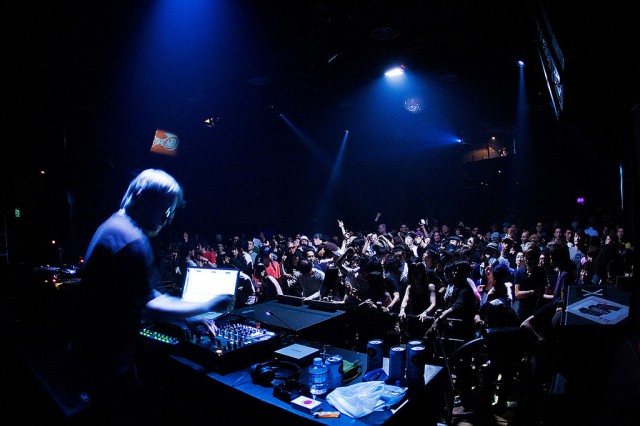There’s a Japanese Taishogoto and vintage Lexicon PCM reverb and loads of computer production. But even for us souls tempted by gear lust, it’s the soul of process that has us talking, and talking, and talking – and listening, on repeat – with Stewart Walker. Native Instruments employee by day, prolific producer by night, he was kind enough to give us an extensive window into his world for CDM.
In the dizzying flurry of music racing past, Stewart Walker’s “Ivory Tower Broadcast” is one I keep coming back to me. It’s one that somehow I’ve gotten closer to on repeated listening.
Without losing any of its forward momentum, this is a record with a permeating sense of laid-back calm, of ease with itself. The opening “Desolation Peak,” for instance, ticks along at an amiable shuffle, all while buzzing with nervous electrical energy tearing along the fringe. “Gone at First Light” slips into the shadows, but it’s inviting, not overly gothic. Delicate and intimate percussion and strums above big synth drones and pads. Throughout, Stewart’s gentle and casual personality shine amidst thick, dark sounds. This is a friendly tap dance at the edge of an abyss.
“Candycoated” is dense and dreamy, in hypnotic motion, a real standout. “Rose Machine” drifts into a shoegaze cloudy sky, but even there, the mix keeps each element clear and distinct, with inventive textures woven into the haze. There are moments where guitar is front-and-center – “Caught in the Switches” – almost echoes Robert Fripp with ambient guitar licks. But the darker moments are never humorless or drab; “Exits Have Been Chained (For Security)” is packed with detail and groovy, ominous with an upturned smile.
So, let’s talk about how he arrived at the record, and how he finds his technical process and voice.
I want to start a bit with the question of sound design, not for technical reasons so much as it seems to me your musical voice here is really rich in timbre. You’re working here with some pretty eclectic materials, but for me they come together in a unified sonic universe. How much is synthesized or starts in the box, or is this recorded?
I did use a lot of computer synthesis, especially for background sounds and ambience. I can easily lose hours inside the Metaphysical Function ensemble in [Native Instruments] Reaktor, for example, and I used the Spiral arpeggiator frequently by experimenting with scales and un-synchronized tempos triggering [Native Instruments] Absynth. I probably only got good results 20% of the time, and I’m not completely comfortable with stochastic composition, but sometimes it’s a great way to get unstuck if I’ve been stuck perfecting a loop for hours.
Otherwise, all of the sounds were recorded live. Aside from the zither, guitar, and koto, shown in my introductory video, I also recorded some xylophones, live drums, and hand percussion, like cabasa, cajon, and maracas. I think the richness comes from how I mix and layer sounds, though. Most parts are doubled and panned with different effects on the left and right channels. I don’t work too much with side-chaining, but I am getting good results lately by grouping unrelated instruments and squashing them into a single shape with heavy compression.
Much of the album’s tonal quality comes from the [Lexicon] PCM-80 and Eventide Harmonizer effects, and my inspiration from their hissy [vintage] quality. Playing a guitar through them transported me directly to shoegaze territory, and the teenager inside me got all excited about finally understanding how these bands got that sound. I think that’s probably why a lot of those Cocteau Twins influences bloomed. Also, I think I got turned on to Jon Hassell’s solo albums around the same time, and his solos of parallel intervals, simply by using pitch shifters. When melodies get doubled, it becomes a little more difficult to find the tonal centre of a song and the mood becomes more mysterious as a result.
There are some really beautiful and unusual sources; can you tell us some of the story of them? This is a crazy looking – zither, at 2:00 in the studio notes video?
Like most producers I’ve known, I think gear lust drives my production a little bit. Sometimes I’ll go through phases of surfing eBay, just to see what’s available and fantasize about what I could do with something new. But I found that searching out synthesizers became a bit mundane, because the synths I dream about have long ago left the realm of affordability.
So, I began researching more exotic acoustic instruments that I’d heard of but didn’t really know much about. I’ve played guitar on and off for most of my life but I am always hesitant to add guitar to electronic music because the sound is so traditional and can easily remove the dislocation I so cherish. So I found that with these open-stringed instruments I could use beautiful string sounds without crossing over into the familiar. And because their interfaces are so unique, I’m forced to play them intuitively without access to my own fallbacks, i.e. no bluesy bends, no barre chords, no 12th, 7th, 5th fret harmonics.
In the YouTube video you mentioned, I’m banging on a Japanese Taishogoto (koto from the [early 20th-century] Taisho era) which is a “granny” instrument in Japan. People have been really curious about this instrument because it looks like a cross between a typewriter and an autoharp. I love it because it has built-in magnetic pickups, so I can plug it directly into the mixer without fiddling with microphones and stands and not panting while recording. The keys drop frets from above the strings, allowing me to play it somewhat like a piano. And the strings are all tuned to the same note, so it’s really easy to detune them from each other.
I’m getting a loose, gauzy sound even before going through any effects.
I know you’re working for a certain music tech manufacturer, but that aside, can you tell us, what’s at the center of your toolset? Do you limit it at some point to stay focused musically?
I feel I must be quite a conservative subject for the CDM audience because I haven’t soldered anything together or written any code to achieve my music. In that regard, my production technique is limited to off-the-shelf hardware and software. Ed.: Hey, I have to cut in here — I’m all for off-the-shelf, too! Sometimes I run out of time to do anything else, partly because of writing this site! I think inventiveness can come from wrestling with tools someone else has built as well as building your own; there are ways to be original with each. And I think readers will agree Stewart fits in just fine on CDM…
95% of my recording and production is in Ableton Live, which is seriously deep enough for me to continue getting lost in. My production limitations stem from a deep suspicion that – with enough time – I can take a brilliant idea and destroy it. So I’ll usually just work on an idea for two hours, put the bounce in my iPod and listen to it for a couple of days until the next steps become obvious. As a result, I usually have 10 unfinished tracks going at any one time. But that makes it easier to think on an album-size scale, since I can isolate techniques across different tracks and force some variety into the process.
Also, to me this is really spatial music; elements feel clearly defined rather than flattened and front-and-center like a lot of music. How compositional was the placement of materials in the mix for you? Was it something that you arranged in the final take, were things sitting in particular places from the beginning of an arrangement, or was there some gradual evolution? (I’m thinking specifically of “Gone at First Light”, “Exits Have Been Chained” at the moment…)
As I mention above, each completed track is the result of hundreds of listens and small tweaks. Getting the melodic and rhythmic ideas down takes only a small portion of time but achieving the moment where all the elements melt together takes much longer. While I’m overdubbing, I’ll do some rough panning and limiting in the beginning to get an idea moving. Later, to get a more immersive sound, I will often take an effect that’s working well on its own, group it with itself in Ableton, and then pan the effected version with a dry version on the opposite side.
It gets to the point when I’m nervous to listen to the mono sum, because I always expect ugly phase cancellations. I have to give a lot of credit to Stefan Betke/Pole [of Scape] Mastering, because no matter how much detail and beauty I try to give a track during its production, it always comes back from the mastering studio that much richer and deeper and more powerful. I’ve been mastering for Native Instruments for three years and I feel like I’ve got a good handle on the appropriate EQ’ing and dynamics, but controlling the stereo spread via MS [Mid/Side] is still quite mysterious to me. How wide is too wide, you know?
“Ivory Tower” usually conjures up negative connotations – and yes, I am arguably a recovering academic. But what did that mean for you?
I was vaguely aware of the negative connotations of the Ivory Tower in academia, especially in the social sciences. But obviously art and music follow a completely different set of rules. In my opinion, the greatest artists must create a world in their head before bringing it out. So to me, the Ivory Tower is a jokey metaphor for “up in my head” or just being in my studio. I also wanted to express a withdrawal from musical or social scenes. Not to be an elitist, but in an effort to actually concentrate on what I’m trying to say musically. After 17 years of making tracks, first as an unknown and then as a respected producer, I yearned for the early years when I just made tracks for their own merit and to share with friends, without concern for label tastes, record reviews or stimulating booking requests. Tracks started to feel utilitarian and what I really wanted to do was get lost in sound again, in the possibilities lurking behind the synth presets and accepted techniques.
I often gain inspiration from studying the habits of painters, because the process of putting paint to canvas is slow and deliberate, and requires not only forethought about what you’re going to paint, but also the technique and concentration to bring that vision into reality. Music, on the other hand, has this long history where atavism equals authenticity, and the best recordings are spontaneous acts of latent unstudied genius. The general trend is for musicians to claim ignorance of their techniques and motivations, and for studio engineers (on Gearslutz for example) to denigrate adding too many plug-ins or to belabor a composition because of the risk that you’ll squeeze the life out of the performance. By comparison, fine art has this luxury that each object can set up its own rules for understanding and appreciation, existing sui generis.
You’re from Atlanta; I’m from Louisville. Now, you’ve been in Berlin quite a lot longer than I have; I’d even go as far as saying you’re one of the people that has defined what it means to be an American electronic musical artist here now. But I wonder how you view your identity, musically speaking. You talked in some other interviews about not wanting to appropriate something that’s not your own. Is techno a sort of modern folk music, in which we all have some common claim? Is there some part of that background as an American (from the Southern suburbs, no?) that connects with your music now? Or is music a chance to escape those identities?
Growing up in the suburbs of Atlanta in the 80s, it felt like a non-place to me. Like I was biding my time to go to a more exciting city, my imagination fueled by novels and music magazines. At the time I wanted nothing to do with the ubiquitous classic rock or country music that was so popular, but now that I’m not inundated with that music anymore, I can appreciate it. It’s harder to talk about my own identity, though. I always wish I could write lyrics for these tracks, but I have very little to say for posterity. Whereas I have a lot to say with sound.
It’s clear to me that the tools available today make everybody a kind of techno musician. Consider the techniques of contemporary heavy metal production, where the drummer only triggers samples which are further quantized by the engineer until the end result might as well be a drum machine. Notions of electronica or lap-pop are no longer distinct, because with the exception of the White Stripes or Kitty Daisy and Lewis, all music is passing from a performer into a DAW where it’s getting re-assembled, remixed and mastered.
After making statements about feeling uncomfortable adopting other tropes from Detroit or Berlin, I realized it doesn’t really matter because I’m ultimately an interpreter. Not of songs, but of production techniques. As much as I dread the ramifications of Simon Reynold’s Retromania, I feel like its living embodiment sometimes. I’m inspired by the dry drum kits of early 70s rock records, or Peter Hook’s chorused bassline on Procession, from Nikhil Banerjee’s solo sitar recordings to Jaco Pastorius’s Portrait of Tracy. And I can assemble all of these influences into some kind of melange because of my sequencing skill set, which comes from directly from techno. But I also don’t really concern myself about whether my work is contemporary or futuristic.
Speaking of techno, we’re at a moment where its boundaries seem somewhat restrained again. Here, though, I’d say “techno” is ephemeral, fluid – an atmosphere rather than a genre. Where would you place its role in this record, or in your other present activities?
This is a very personal question, actually, because I feel like techno music was my true love for the longest time. Hearing Daniel Bell’s “Spock’s Brain,” Robert Hood’s “Untitled (The Figure),” and Regis’s “Gymnastics” all in ’96 or ’97 literally changed my life by inspiring me to quit my day job after saving up some living expenses from my day job. All the raves that I’d been to at the point were a bit of a letdown, but I really gelled with these artists for being so uncompromising. No melody, no tricky rhythm, just “Here’s the future, now you know.”
Two days ago, though, I was watching a friend’s video from Berlin’s 25th anniversary Mauerfall celebration, and part of the footage was naturally a techno street party and the DJ was playing “Losing Control” and I recoiled in frustration. Though I loved these tracks 17 years ago, I didn’t know they would be the future so literally. Sometimes I compare early/late techno with the the development of Bauhaus ideas about furniture and mass production into the Ikea reality. In both cases, the artists were hand-making objects (or songs) which predicted the sound of the future and it turned out they were correct. But once the future arrived and the ideas transitioned from individual expression to mass production, the shapes were still there but the creative relevance was gone.
However, while proper capital- T Techno has become a Xerox of a mimeograph taken from the urform, there are certainly other creators in different genres who continue to explore rhythmic sound without a steady kick drum or a wash of white noise. I can’t keep up with the firehose of new music while making my own, but I stumble across exciting new options now and again. Right now, I hear a new stop-start non-linearity in songs which I find quite exciting, or ideas forced together which don’t appear to fit together on the first listen but which make sense upon repeated listenings.
“Rose Machine” is a favorite for me; it’s lush, it’s dreamy. We have these wonderful guitar worlds there and in “Gone at First Light.” Can you tell us about where these tracks started for you? I see bass guitars also getting integrated with the digital/analog world – want to share some of that signal chain? And this surely impacts your playing technique, too?
Both of these tracks came about pretty easily. “Rose Machine” began with a Les Paul getting pulsed through an Ernie Ball volume pedal into a Lexicon PCM-80 reverb. It’s easy with that kind of setup to just close your eyes and lean into the pedal. Play for six minutes and then start again on the overdubs. In an afternoon, I’ll lay down 10 tracks, then throw away four and basically have a song structure. Then it will take an additional two weeks of listening, de-noising, EQ’ing before I conclude “this is great but kinda short and the drums are weak.” At which point I’ll record three different ideas on top and feel unsure about the whole thing for the next two months as I add a few things and mute a few others. It’s cheesy to say but these songs need to age a bit before they’re ready. Writing rhythm tracks is now the most difficult part of the process because once I take out the constant kick drum at 60 Hz, that leaves me with a lot of space in the mix, and I have to figure out a new balance for percussion and melody.
“Gone at First Light” was made possible by Sneak-Thief’s modular, especially the Neural Agonizer spring reverb, feeding back into itself. We also built some beats on his [Midibox] MB-808 [Roland TR-808 clone], with me burning the highs on his mixer, and then rerecording the same pattern multiple times to achieve some kind of flamming. That was a track where I worried that not too much was going on compositionally, so I kept adding new sounds and taking them away until I finally accepted it was complete.
That KORG Wavedrum does some amazing things, and seems part of this future-apocalypse tribe, dirty place. What are we hearing there, exactly?
I love the Wavedrum because like the koto and zither, it allows me to use “ethnic” sounds in a completely non-ethnic way. For example, off the top of my head, I have no idea where a darabuka comes from or what it looks like without reference. But I know what it sounds like, and how to balance the sharp noisy attack vs FM synth-sounding decay into a track. I can’t really play a convincing pattern, but when I overlay multiple takes of a performance and start panning and quantizing it, I can achieve a good balance between tight rhythm and flammy chaos.
As I mention above, about how the guitar sounds a little bit too familiar, I can say the same thing about acoustic drums or analog drum machines. The physical models of hand-drums fit quite well into electronic compositions if I don’t try to sound “tribal” or authentic with it. Of course the Wavedrum also has the occasional weak General MIDI sounding patch, but we’ve accepted 20 years of the Roland TR-727, so I don’t worry too much about it.
You’ve also done a Remix Set for Traktor based on the record. What was that process like, building those sounds for that context? How do you envision these differently, making tools that are also used by other people? And, for that matter, are Remix Sets something you’re using now in your own live work?
Beatport: Ivory Tower Broadcast Traktor Remix Set
Most of the remix sets I process follow a song-oriented format so that DJ’s can press any four buttons in a row and get a useful and powerful musical result. My remix sets were a little bit more difficult to process, because so few of the musical phrases fit into a loop-able 2-, 4-, or 8-bar pattern. As I’ve learned with my live show, it’s very difficult to un-sequence some of these tightly composited phrases because they lose their magic in isolation. So I’d say my remix set is more open-ended than the majority of EDM and tech-house productions which I master for NI.
In my live show, I’m still based on Ableton Live, because I couldn’t play a live show without Follow Actions. Telling a hi-hat to stop after 32 bars and a snare to stop at 64 bars provides me with valuable cues about where I am in a song and when I should transition to the next piece. I enjoy the productive aspect of starting new sounds in a live show, but turning them off again feels like “housekeeping” and takes me out of the creative pocket.
Still, I use the Remix Sets a lot in the studio. Recording live inputs to the loop recorder, capturing them to a cell in a remix set and then scratching the sound using a [Traktor Kontrol] S4’s jogwheels or running doubles of a sound across two decks to achieve natural flanging. Traktor is an amazing scratch pad for recording and sound design. In fact as I write this, I’m thinking that I should record more of the Wavedrum into Traktor when I’m building rhythms, to put these two techniques together.
You’ve been absurdly active in the past years; most recently, that’s involved a live set in Boiler Room, for instance. Can you tell us about your live performance rig, and how you structure your live sets?
My live show is in the middle of a massive transition right now. The Boiler Room show was the first time I brought out the koto for a live performance, but I wasn’t able to use it fully due to some technical difficulties with the DI-box which cropped up between soundcheck and the show. I hate 9-volt batteries.
But now that I’ve committed to this new musical direction in the studio, the next step is figuring out how to play it live. I’ve played five shows since that Boiler Room performance and each time it’s been different. At Helsinkiklub in Zurich, I sat down so I could concentrate on playing the koto as a main instrument rather than just a spice on a more typical loop-based set. Then when I played the release party at Roter Salon in Berlin, my friend and studio partner Sam Rouanet played drums on top of my melodies. That seems like it will be the next step for the show, moving away from the laptop and more and more into a fully live sound.
Otherwise, it’s good for me to keep some kind of techno sequencing for the live show by playing loops that fill up space without being super novel on their own. Using Ableton in a rhythm guitarist role while I perform more improvisations on top. I just need to find the balance so I can trigger clips and move the set along while simultaneously soloing on the instruments. The next difficulty is figuring out which kind of audience actually wants to come and see this music and in which kind of venue. Techno performances were much easier because I knew what the people wanted to hear, and the nightclubs have more of a built-in audience than rock clubs or theaters.
Also, you’re turning back to solo music with this release after some collaborative efforts. What can we hear of that?
Sadly, none of these collaborative releases are out yet and their future is still a bit nebulous. I’ve been talking a lot about this album I made with Marco Tonni under the name “Golden Parachutes” and I really want to see it come out even if it’s just a digital release. In my opinion, Golden Parachutes was the turning point for me between techno and this new style, because Marco and I were simultaneously excited by recording more than just sequencing.
What’s next? Upcoming live or studio projects we should know about?
Sam Rouanet and I will be performing again on December 11th at ACUD in Berlin, and taking the Ableton & Koto & Live Drums idea a bit further. In the studio, I’m working on my next album titled Flatwound/Modal. That began directly after the Ivory Tower Broadcast sessions and the original series of recordings were a little bit too familiar to the ITB sound so I’m still recording new stuff until I feel a new identity begin to emerge.
As you can tell from the title, there’s going to be a lot more bass, and some attempts to connect techno with its potentially lost spiritual predecessor of modal jazz. You know, long repetitive tracks that never change key but instead create and fully explore a limited musical space until all sensible possibilities of rhythm, tone and timbre have been examined. Also, I’m trying to pick up the pace so that there’s some invigoration to counter the enervation.
What are you listening to today, from around Berlin or beyond? It strikes me that in your musical practice, you’re well beyond what’s usually expected, so I’d love to hear even a handful of picks of things you’re enjoying now.
My big love of the last month has been Lightning Bolt’s performance from Taicoclub 2014 on Youtube. From a performance standpoint, I love how the music feels so out of control, yet the bass player’s face shows only concentration and focus, and he smirks only once during the whole clip, as if to acknowledge how awesome it is. I like watching the poor security guards trying physically hold off thousands of mashing bodies and imagine the stories they tell their wives the evening after this show
.
Second, I downloaded this album from Bandcamp recently called “Flock Migrates Over the Pines” by Madison, WI artists BC Grimm which is all solo performances on a Chinese guqin, but played using a more Western scale and it’s beautiful and meditative much like Brian Eno’s “Thursday Afternoon.”
Finally, I’ve finally found the time to delve into early Talking Heads. As a kid, I hated “Burning Down the House” and as an adult, I didn’t ever understand why “My Life in the Bush of Ghosts” was so special but Spotify allowed me to discover “Fear of Music” and “Remain in Light.” Since I’ve been studying so much Afrobeat in the last 5 years, it’s very educational to see how this band from Providence/NY modified the whole Fela Kuti/Tony Allen orchestration and make it sound more pop, more urban, and with a different instrumental palette from synthesizers. I’m still trying to figure out where the line is between cultural appropriation and reinvention. Because I hear a bit of both here and it informs me in my own interpretations. How much to borrow, how much to steal, and most importantly how much to ignore.
